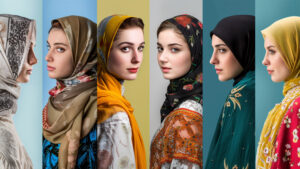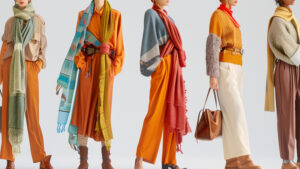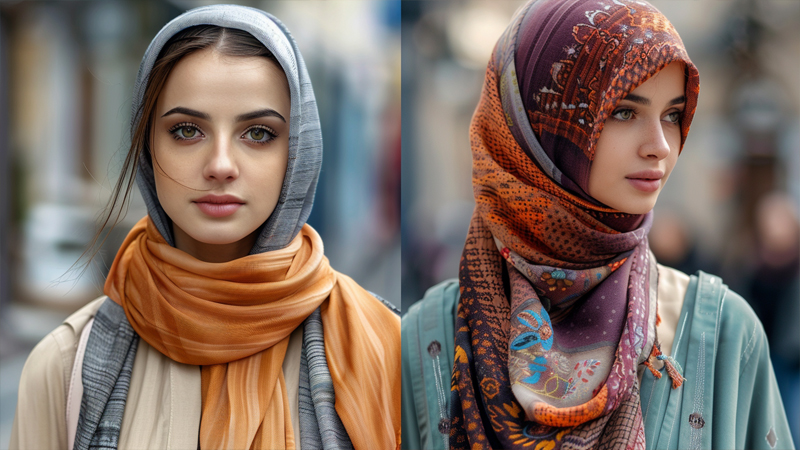
I've always loved how a simple scarf can boost any outfit. But there's a unique story behind hijab scarves, and it's more than just a stylish accessory.
Hijab scarves differ from regular scarves in design, material, and purpose, providing coverage while reflecting personal and cultural identity. Understanding these differences can help you choose the right style.
For me, it's a fascinating discovery that sparks deeper curiosity about both function and tradition.
How do design and functionality differ between hijab scarves and regular scarves?
Design shapes how a scarf drapes, while functionality influences comfort and coverage. Hijab scarves must balance modesty with personal flair, unlike typical scarves for general warmth or style.
Hijab scarves prioritize coverage, secure draping, and cultural expression, while regular scarves often focus on fashion or warmth. Both can be stylish, but their functions vary.
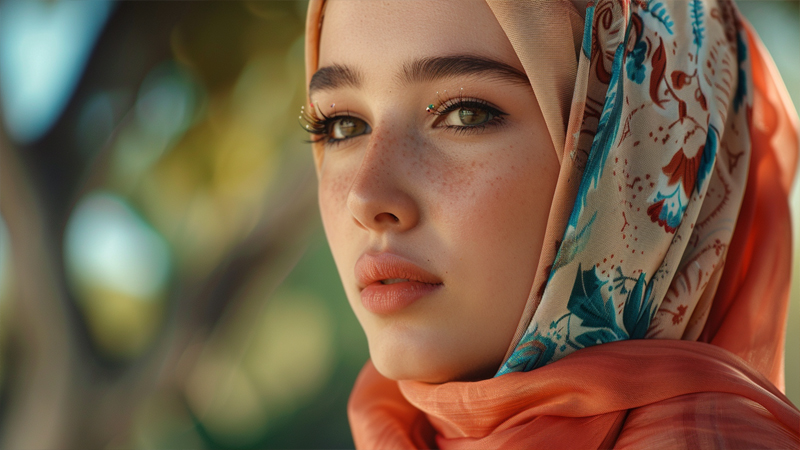
A Closer Look at Design and Functionality
I remember the first time I tried on a hijab-style scarf; I felt a gentle tuck around my face, ensuring everything stayed in place. I couldn’t help noticing how purposeful the design was—enough coverage to feel comfortably modest, but also flexible enough to personalize my look. Traditional scarves I’d worn before could slip easily if not secured with pins or knots, and they often served as a light layer around my neck or shoulders rather than offering full coverage.
When we talk about hijab scarves1, the shape often matters. A rectangular cut or a large square design can make or break the draping style. These shapes help provide consistent coverage around the head and neck, which is crucial for those who choose to wear it for religious or cultural reasons. On the other hand, a regular scarf could be short, narrow, or even triangular—usually just enough to wrap around once or twice for warmth or a pop of color.
Functionality goes beyond looks. Hijab scarves often feature breathable fabrics2 and strategic tailoring to minimize slippage, making them comfortable for daily wear. I appreciate how this attention to detail keeps me from fussing with constant adjustments throughout the day. A regular scarf rarely comes with that level of design nuance, mainly because its purpose is less about coverage and more about style or warmth.
Below is a quick comparison:
| Aspect | Hijab Scarves | Regular Scarves |
|---|---|---|
| Coverage | Usually covers hair and neck fully | Typically used around neck/shoulders |
| Shapes | Larger rectangle/square for security | Various shapes (rectangle, square) |
| Functionality | Cultural, religious, style balance | Style, warmth, occasional flair |
| Materials | Lightweight, breathable fabrics | Can be thicker for warmth |
| Accessories | Often requires pins or underscarves | Rarely needs extra accessories |
All of these details highlight how something as simple as a piece of fabric can carry deeper meaning and practical considerations. Whether you wear a hijab by choice or simply love collecting scarves, understanding their unique design and function can open up a new appreciation for how they feel, fit, and represent a piece of culture.
What material choices are preferred for hijabs compared to regular scarves?
Lightweight options with breathability and opacity define hijab-friendly materials. Regular scarves often use heavier or more decorative fabrics for warmth or fashion purposes.
Most hijab scarves use breathable materials like cotton, jersey, or chiffon for comfortable coverage, while regular scarves might include wool or silk for warmth or flair.
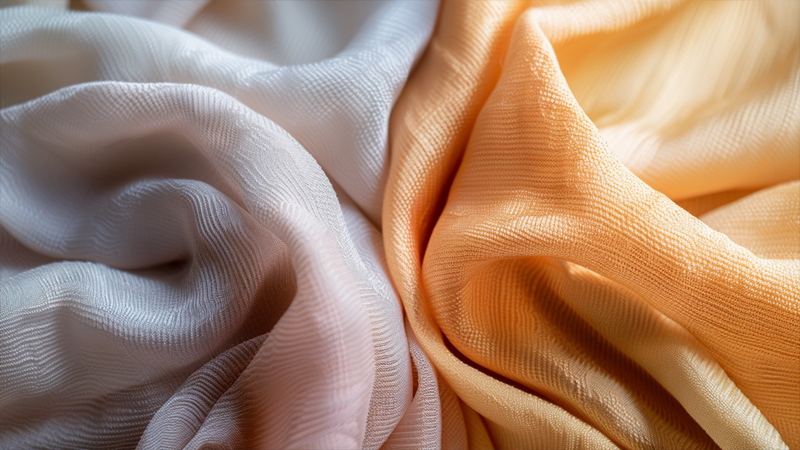
Embracing the Right Fabric
When I first experimented with hijab styles, I quickly discovered that not all fabrics were created equal. One day, I tried a shiny satin scarf for a friend’s wedding—thinking it looked elegant—and spent the entire evening fussing over its slippery edges. Later, I learned that many hijab scarves are crafted from cotton blends or jersey3 because these fabrics hold their shape beautifully, stay in place, and offer enough thickness to remain opaque, fulfilling the modesty aspect.
In contrast, regular scarves can be made from anything: thick wool to beat the cold, delicate cashmere to add luxury, or even sheer organza for a decorative touch. While these materials can be stunning, they aren't always practical for hijab use. Sheer fabrics, for example, require an underscarf for proper coverage, and heavy wool might feel too warm for everyday hijab wear.
A great hijab scarf feels soft against the skin, allows air to circulate so you’re not sweating, and drapes elegantly without requiring constant adjustments. Meanwhile, a regular scarf—whether it’s to fight off winter chills or complete an outfit—might prioritize texture, pattern, or warmth over breathability.
Sometimes I mix and match: a cozy pashmina scarf4 on colder days, paired with an undercap, can double as a hijab-friendly piece if carefully secured. I love how a single scarf can transition across purposes with just a bit of creativity. Ultimately, your choice might hinge on climate, comfort, and how much coverage you’re seeking. Thinking about fabric composition can make or break your day, especially if you’re on the move and rely on your scarf to remain as put-together as you are.
What styling techniques are unique to hijabs that differentiate them from regular scarves?
Styling a hijab may include pinning, wrapping, and layering for coverage, whereas regular scarves often need simpler draping and might not require secure fastening.
Hijab styling highlights coverage and creative layering, using pins or underscarves, setting it apart from the casual wrap of regular scarves.
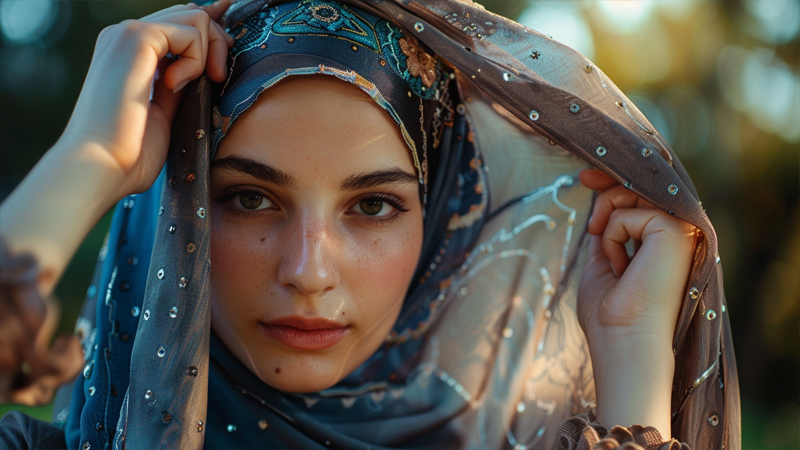
Unpacking Unique Styling Methods
I’ve discovered that hijab styling can feel like an art form, much like painting on a canvas. For me, it’s about personal expression: a quick wrap and pin if I’m rushing to brunch, or a more elaborate layered look if I’m dressing up for a special event. There’s something satisfying about adding a tiny decorative pin5 near the ear, not just for practicality but also for a subtle sparkle.
Regular scarves typically don’t require such a process. You can sling them around your neck, toss one end over the shoulder, and call it a day. But hijab scarves often involve steps that ensure no hair is revealed, which can mean using underscarves, specialized pins, or even magnet fasteners (a small miracle for anyone who’s tired of poking themselves with sharp pins—yes, I’ve done that many times!).
Some hijab styles incorporate folded edges for a crisp line around the face, while others let the material fall softly for a laid-back vibe. I’ve also seen braided hijab techniques6 or layered drapes that create gorgeous silhouettes. Watching tutorials or chatting with friends who’ve mastered this craft can be inspiring. It goes beyond function and into the realm of self-expression, which I find incredibly beautiful.
I still remember the first time I nailed a more complex hijab style, all by myself, for a family gathering. It felt like a tiny victory—like I’d unlocked a secret level in a game. This is the hidden joy behind hijab styling; it’s more than just coverage. It’s about creativity, personal flair, and the sense of confidence that comes with perfecting a look that’s fully you.
How does the purpose and usage of hijabs differ from that of regular scarves in daily life?
Hijabs often symbolize modesty and cultural identity, while regular scarves serve more general fashion or utility purposes like warmth or accessorizing.
Hijabs hold cultural and religious significance, guiding modesty and identity, whereas regular scarves offer casual style or function without those deeper implications.

Reflecting on Purpose in Everyday Moments
While I see scarves as a must-have accessory—especially during chilly mornings—the hijab holds an even deeper purpose for many. Some wearers see the hijab as a declaration of faith or identity, a visible way to practice modesty7 and remain connected to their roots. I find it moving that a simple piece of fabric can reflect so much culture, faith, and personal storytelling.
In my daily routine, a regular scarf might be tossed around my neck while I’m headed out the door, simply to keep warm. But when I’m wearing a hijab, there’s a more deliberate process. For me, it might mean planning my outfit to ensure everything aligns with my comfort level and personal expression8. I love that I can use color and style to show my mood, all while honoring a tradition that runs deep in some communities.
That’s the key difference: a regular scarf can be purely functional or decorative, but a hijab often carries layers of meaning—sometimes literally. The subtle act of pinning a hijab in place can evoke a sense of continuity with generations who’ve done the same. Meanwhile, wearing a regular scarf might just be a last-minute decision to spice up a simple sweater or protect my neck from a brisk breeze.
Some people opt to wear hijabs daily, others only during certain religious or cultural events. Regular scarves, on the other hand, tend to come out of the closet whenever the weather or an outfit calls for a little accessorizing. Recognizing these nuanced uses and the emotions tied to them can help us appreciate the beauty and diversity of scarf wearing in all its forms.
Conclusion
Both scarves serve different needs. Understanding these nuances helps us honor each style’s purpose and cultural context.
-
Explore this link to discover top-rated hijab scarves that combine comfort, style, and functionality, perfect for daily wear. ↩
-
Learn about the advantages of breathable fabrics, which enhance comfort and wearability, especially in hijab scarves. ↩
-
Learn why cotton blends and jersey fabrics are favored for hijabs, ensuring comfort and style in your daily wear. ↩
-
Discover the versatility and benefits of pashmina scarves, perfect for adding warmth and style to your outfits. ↩
-
Learn how decorative pins can add a unique touch to hijab styles, making them both practical and stylish. ↩
-
Check out this link for popular braided hijab techniques that can elevate your styling game and inspire creativity. ↩
-
Understanding how modesty shapes fashion can provide insights into diverse cultural expressions and personal identities. ↩
-
Discovering various fashion expressions can inspire you to embrace your own style and identity creatively. ↩

